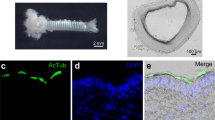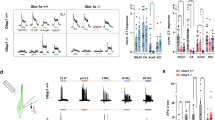Abstract
THE role of cyclic nucleotides in stimulus-response coupling at the cellular level has received much attention1. The level of adenosine cyclic 3′,5′-monophosphate (cAMP) is dependent on its rate of synthesis, catalysed by adenyl cyclase, and on its rate of destruction, catalysed by phosphodiesterase. Although most investigators have measured the regulation of cAMP levels by alterations in adenyl cyclase activity, others have noted the presence of high levels of phosphodiesterase in certain sensory receptors and have suggested that this enzyme may be of special importance in such cells2. We studied the phosphodiesterase activity in tongue epithelium to determine whether unusually high levels of this enzyme might also be associated with taste receptors, and to explore the possibility that taste stimuli might affect phosphodiesterase activity, thereby altering the intracellular cAMP concentrations.
This is a preview of subscription content, access via your institution
Access options
Subscribe to this journal
Receive 51 print issues and online access
$199.00 per year
only $3.90 per issue
Buy this article
- Purchase on Springer Link
- Instant access to full article PDF
Prices may be subject to local taxes which are calculated during checkout
Similar content being viewed by others
References
Rasmussen, H., Science, 170, 404 (1970).
Pannbacker, R. G., Fleishman, D. E., and Reed, D. W., Science, 175, 757 (1972).
Price, S., in Olfaction and Taste (edit. by Schneider, D.), 4 (Springer-Verlag, Berlin, in the press).
Dastoli, F. R., and Price, S., Science, 154, 905 (1966).
Price, S., and Hogan, R. M., in Olfaction and Taste (edit. by Pfaffmann, C.), 3, 397 (Rockefeller University Press, New York, 1969).
Koch, A. L., and Putnam, S. L., Anal. Biochem., 44, 239 (1971).
Cheung, W. Y., in Role of Cyclic AMP in Cell Function (edit. by Greengard, P., and Costa, E.), 51 (Raven Press, New York, 1970).
Fischer, R., and Griffin, F., Arzneimittel-Forsch., 14, 673 (1964).
Pfaffmann, C., in Handbook of Physiology (edit. by Field, J.), 1, sec. 1, 507 (American Physiological Society, Washington, 1959).
Drummond, G. I., and Perrott-Yee, S., J. Biol. Chem., 236, 1126 (1961).
Butcher, R. W., and Sutherland, E. W., J. Biol. Chem., 237, 1244 (1962).
Koyama, N., and Kurihara, K., J. Gen. Physiol., 57, 297 (1971).
Author information
Authors and Affiliations
Rights and permissions
About this article
Cite this article
PRICE, S. Phosphodiesterase in Tongue Epithelium: Activation by Bitter Taste Stimuli. Nature 241, 54–55 (1973). https://doi.org/10.1038/241054a0
Received:
Revised:
Issue Date:
DOI: https://doi.org/10.1038/241054a0
This article is cited by
-
Signalling mechanisms in PAF-induced intestinal failure
Scientific Reports (2017)
-
A bitter-sweet beginning
Nature (1996)
-
A cyclic–nucleotide–suppressible conductance activated by transducin in taste cells
Nature (1995)
-
Coupling of bitter receptor to phosphodiesterase through transducin in taste receptor cells
Nature (1995)
-
Biochemical analysis of the transducin-phosphodiesterase interaction
Nature Structural Biology (1994)
Comments
By submitting a comment you agree to abide by our Terms and Community Guidelines. If you find something abusive or that does not comply with our terms or guidelines please flag it as inappropriate.



